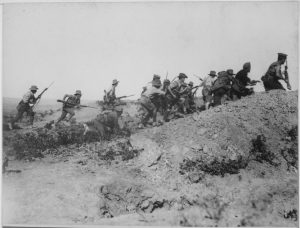
Australian troops charging near a Turkish trench during the Gallipoli Campaign, circa 1915
The Gallipoli Campaign (also called the Dardanelles Campaign) was a World War I Allied offensive on the Gallipoli Peninsula in Turkey. It lasted February 17, 1915, through January 9, 1916, and was ultimately unsuccessful, ending in high casualties and evacuation.
Background
With trench warfare causing stagnation on the Western Front, the British and French decided to launch an attack against the Ottoman Empire, one of the Central Powers, in 1915. The plan was to use naval power to break through the Dardanelles (a strait connecting the Mediterranean to the Black Sea) and then capture the Turkish capital of Constantinople (Istanbul).
Landings
The naval attack began in February and March 1915, but hidden mines made the British and French ships withdraw in failure. The land offensive began on April 25.
78,000 troops from across the British Empire and France landed on the Gallipoli Peninsula at Cape Helles and what would become known as Anzac Cove (named for the Australian and New Zealand troops that landed there). Some landings were met with fierce resistance and high casualties, while others were accomplished without much opposition.
Stalemate
However, once the troops came ashore, little progress was made, and attempts to push forward were halted by the Turks and their German allies. Despite renewed offensives (most notably at Suvla Bay in August) and reinforcements over the coming months, both sides settled into a high-casualty stalemate from within a system of trenches.
Evacuation
Finally, the Allies evacuated Anzac Cove and Suvla Bay in December 1915, and Cape Helles in January 1916. Amazingly, the British and French were able to evacuate some one hundred thousand men secretly and with very limited casualties, making the evacuation arguably the most successful part of the whole campaign.
Casualties
By the time they left, the Allied Powers had sustained some 200,000 casualties (killed, injured, or sick) and the Turks had suffered at least 87,000 deaths, with many more in other casualties.
Learn more about the Gallipoli Campaign through historical newspapers from our archives. Explore newspaper articles, headlines, images, and other primary sources below.
Articles and Clippings about the Gallipoli Campaign
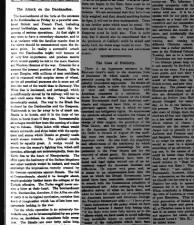 Excerpt from an editorial about the advantages if the naval attack on the Dardanelles is successful Mon, Feb 22, 1915 – Page 25 · The Times (London, Greater London, England) · Newspapers.com
Excerpt from an editorial about the advantages if the naval attack on the Dardanelles is successful Mon, Feb 22, 1915 – Page 25 · The Times (London, Greater London, England) · Newspapers.com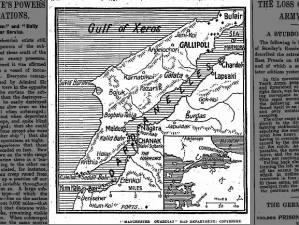 Map of the Dardanelles and Gallipoli Peninsula in Turkey, printed in 1915 Tue, Feb 23, 1915 – 10 · The Guardian (London, Greater London, England) · Newspapers.com
Map of the Dardanelles and Gallipoli Peninsula in Turkey, printed in 1915 Tue, Feb 23, 1915 – 10 · The Guardian (London, Greater London, England) · Newspapers.com Photos of 3 Allied ships sunk by mines during the naval attack on the Dardanelles Fri, Mar 26, 1915 – 1 · The Province (Vancouver, British Columbia, Canada) · Newspapers.com
Photos of 3 Allied ships sunk by mines during the naval attack on the Dardanelles Fri, Mar 26, 1915 – 1 · The Province (Vancouver, British Columbia, Canada) · Newspapers.com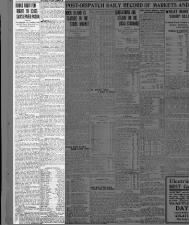 Associated Press interview with Enver Pasha, Ottoman War Minister Tue, Apr 20, 1915 – Page 21 · St. Louis Post-Dispatch (St. Louis, Missouri) · Newspapers.com
Associated Press interview with Enver Pasha, Ottoman War Minister Tue, Apr 20, 1915 – Page 21 · St. Louis Post-Dispatch (St. Louis, Missouri) · Newspapers.com Landings begin during the Allied land offensive on the Gallipoli Peninsula, April 1915 Tue, Apr 27, 1915 – Page 26 · The Times (London, Greater London, England) · Newspapers.com
Landings begin during the Allied land offensive on the Gallipoli Peninsula, April 1915 Tue, Apr 27, 1915 – Page 26 · The Times (London, Greater London, England) · Newspapers.com Firsthand accounts of the landings at the beginning of the Gallipoli Campaign Fri, Jun 11, 1915 – Page 11 · The Age (Melbourne, Victoria, Australia) · Newspapers.com
Firsthand accounts of the landings at the beginning of the Gallipoli Campaign Fri, Jun 11, 1915 – Page 11 · The Age (Melbourne, Victoria, Australia) · Newspapers.com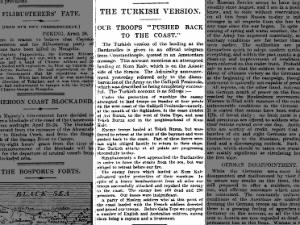 Turkish perspective on the opening days of the Gallipoli Campaign landings Wed, Apr 28, 1915 – Page 26 · The Times (London, Greater London, England) · Newspapers.com
Turkish perspective on the opening days of the Gallipoli Campaign landings Wed, Apr 28, 1915 – Page 26 · The Times (London, Greater London, England) · Newspapers.com Infographic image showing "Where Allies are Fighting the Turk on Land and Water" Fri, May 7, 1915 – Page 16 · Vancouver Daily World (Vancouver, British Columbia, Canada) · Newspapers.com
Infographic image showing "Where Allies are Fighting the Turk on Land and Water" Fri, May 7, 1915 – Page 16 · Vancouver Daily World (Vancouver, British Columbia, Canada) · Newspapers.com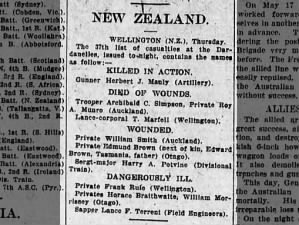 Example of a casualty list of New Zealand soldiers printed during the Gallipoli Campaign Fri, May 28, 1915 – Page 9 · The Sydney Morning Herald (Sydney, New South Wales, Australia) · Newspapers.com
Example of a casualty list of New Zealand soldiers printed during the Gallipoli Campaign Fri, May 28, 1915 – Page 9 · The Sydney Morning Herald (Sydney, New South Wales, Australia) · Newspapers.com Letters from Australian soldiers with eyewitness accounts of the Gallipoli Campaign Sat, Jun 12, 1915 – Page 13 · The Age (Melbourne, Victoria, Australia) · Newspapers.com
Letters from Australian soldiers with eyewitness accounts of the Gallipoli Campaign Sat, Jun 12, 1915 – Page 13 · The Age (Melbourne, Victoria, Australia) · Newspapers.com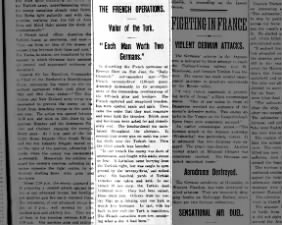 Newspaper correspondent describes "French operations at Kereves Dere on 21st June" Sat, Jul 3, 1915 – Page 11 · The Age (Melbourne, Victoria, Australia) · Newspapers.com
Newspaper correspondent describes "French operations at Kereves Dere on 21st June" Sat, Jul 3, 1915 – Page 11 · The Age (Melbourne, Victoria, Australia) · Newspapers.com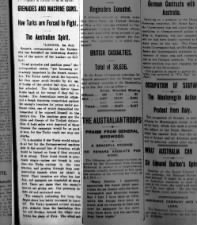 Excerpt from a newspaper description of "the nature of the warfare on Gallipoli" dated July 1915 Sat, Jul 3, 1915 – Page 11 · The Age (Melbourne, Victoria, Australia) · Newspapers.com
Excerpt from a newspaper description of "the nature of the warfare on Gallipoli" dated July 1915 Sat, Jul 3, 1915 – Page 11 · The Age (Melbourne, Victoria, Australia) · Newspapers.com Ian Hamilton and Enver Pasha make statements on the status of the Gallipoli Campaign in August 1915 Thu, Aug 12, 1915 – Page 3 · San Francisco Chronicle (San Francisco, California) · Newspapers.com
Ian Hamilton and Enver Pasha make statements on the status of the Gallipoli Campaign in August 1915 Thu, Aug 12, 1915 – Page 3 · San Francisco Chronicle (San Francisco, California) · Newspapers.com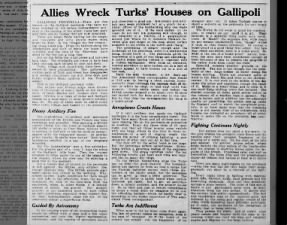 Newspaper column describes effects of Allied bombardment on the Gallipoli Peninsula Sat, Aug 14, 1915 – Page 15 · The Winnipeg Tribune (Winnipeg, Manitoba, Canada) · Newspapers.com
Newspaper column describes effects of Allied bombardment on the Gallipoli Peninsula Sat, Aug 14, 1915 – Page 15 · The Winnipeg Tribune (Winnipeg, Manitoba, Canada) · Newspapers.com Excerpt from list of British soldiers awarded Distinguished Conduct Medal for actions at Gallipoli Thu, Sep 16, 1915 – 4 · The Guardian (London, Greater London, England) · Newspapers.com
Excerpt from list of British soldiers awarded Distinguished Conduct Medal for actions at Gallipoli Thu, Sep 16, 1915 – 4 · The Guardian (London, Greater London, England) · Newspapers.com Turkish minister of war Enver Pasha comments on Turkey's relationship with Germany during Gallipoli Mon, Sep 20, 1915 – 2 · The Los Angeles Times (Los Angeles, California) · Newspapers.com
Turkish minister of war Enver Pasha comments on Turkey's relationship with Germany during Gallipoli Mon, Sep 20, 1915 – 2 · The Los Angeles Times (Los Angeles, California) · Newspapers.com "Behind the Turkish Lines; Gallipoli Through German Eyes" Mon, Oct 18, 1915 – 5 · The Guardian (London, Greater London, England) · Newspapers.com
"Behind the Turkish Lines; Gallipoli Through German Eyes" Mon, Oct 18, 1915 – 5 · The Guardian (London, Greater London, England) · Newspapers.com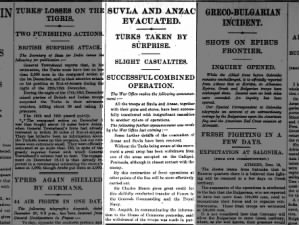 Allied troops successfully evacuated from Anzac Cove and Suvla Bay, December 1915 Tue, Dec 21, 1915 – Page 46 · The Times (London, Greater London, England) · Newspapers.com
Allied troops successfully evacuated from Anzac Cove and Suvla Bay, December 1915 Tue, Dec 21, 1915 – Page 46 · The Times (London, Greater London, England) · Newspapers.com Newspaper prints other newspapers' reactions to the evacuations at Anzac Cove and Suvla Bay Wed, Dec 22, 1915 – Page 6 · The Hamilton Spectator (Hamilton, Victoria, Australia) · Newspapers.com
Newspaper prints other newspapers' reactions to the evacuations at Anzac Cove and Suvla Bay Wed, Dec 22, 1915 – Page 6 · The Hamilton Spectator (Hamilton, Victoria, Australia) · Newspapers.com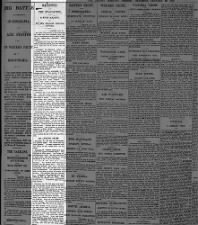 New Zealand medical officer gives eyewitness account of the evacuation of Anzac Cove Sat, Jan 22, 1916 – Page 15 · The Sydney Morning Herald (Sydney, New South Wales, Australia) · Newspapers.com
New Zealand medical officer gives eyewitness account of the evacuation of Anzac Cove Sat, Jan 22, 1916 – Page 15 · The Sydney Morning Herald (Sydney, New South Wales, Australia) · Newspapers.com Newspaper article reports "Complete Evacuation of Gallipoli Peninsula Successfully Achieved" Mon, Jan 10, 1916 – 7 · Saskatoon Daily Star (Saskatoon, Saskatchewan, Canada) · Newspapers.com
Newspaper article reports "Complete Evacuation of Gallipoli Peninsula Successfully Achieved" Mon, Jan 10, 1916 – 7 · Saskatoon Daily Star (Saskatoon, Saskatchewan, Canada) · Newspapers.com Comparison between trenches in France and Anzac trenches at Gallipoli Mon, Jan 24, 1916 – Page 9 · The Age (Melbourne, Victoria, Australia) · Newspapers.com
Comparison between trenches in France and Anzac trenches at Gallipoli Mon, Jan 24, 1916 – Page 9 · The Age (Melbourne, Victoria, Australia) · Newspapers.com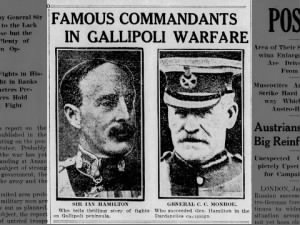 Photos of two British generals of the Gallipoli Campaign, Ian Hamilton and Charles Monro Fri, Jan 7, 1916 – 1 · The Vancouver Sun (Vancouver, British Columbia, Canada) · Newspapers.com
Photos of two British generals of the Gallipoli Campaign, Ian Hamilton and Charles Monro Fri, Jan 7, 1916 – 1 · The Vancouver Sun (Vancouver, British Columbia, Canada) · Newspapers.com